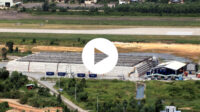Woodard and Curran develops In-situ PFAS remedy in partnership with Brown University
.jpg?1668433097)
Study members: Lucas Hellerich PHD, PE, LEP (Practice Leader / Remediation Engineering) and Dan Bryant, PhD, PG Director of Practices Environmental Remediation.
Woodard & Curran remediation experts contributed to the development of a first-of-its-kind in-situ remediation technology to destroy PFAS compounds in groundwater.
In partnership with researchers at Brown University, members of Woodard & Curran’s Environmental Remediation group published Low-temperature persulfate activation by powdered activated carbon for simultaneous destruction of perfluorinated carboxylic acids and 1,4-dioxane in the Journal of Hazardous Materials. Director of Technical Practices Dan Bryant, PhD., and Practice Leader Lucas Hellerich, PhD., are coauthors of the research paper.
The firm’s remediation professionals developed a research idea in response to a growing need for low-impact in-situ PFAS destruction technologies. While the ability of catalyzed persulfate to destroy certain classes of PFAS compounds is established, those other methods require elevated temperatures to degrade these contaminants in groundwater. Other existing methods require costly, unsustainable, and time-consuming pump-and-treat systems and management of additional waste streams for treated effluent. Until now, in-situ PFAS solutions have been limited to sorptive sequestration technologies. The research team sought to develop technology to destroy PFAS compounds at lower temperatures found in groundwater, seeking an appropriate persulfate catalyst that could effectively address contamination without extracting groundwater or heating the aquifer.
Drs. Bryant and Hellerich collaborated with Brown researchers to design the study, review results, and adjust course to pursue a viable low-temperature persulfate catalyst. Experiments were conducted at the Pennell Lab at the School of Engineering at Brown University. Early experiments studied metal catalysts, which were not effective. Dr. Katherine E. Manz, a research professor at Brown, suggested testing powder-activated carbon, which proved effective in the degradation of perfluorocarboxylic acids – a common class of PFAS compounds.
With positive, replicable results achieved in the laboratory setting, Woodard & Curran’s remediation group plans to deploy the technology in the field. Reagents will be combined in a slurry and applied via controlled jet injection at temporary well points, with no permanent above-grade equipment or facilities to install or maintain, and no secondary waste stream created. Compared to traditional pump-and-treat remediation and multi-phase sequestration and destruction techniques, low-temperature persulfate activation by powdered activated carbon presents a cost-effective, sustainable, and passive alternative to resolving complex groundwater contamination.
While currently extending this technology to Woodard & Curran’s client base, the research team will continue to study wider applications. In addition to perfluorocarboxylic acids, these reagents also have the potential to degrade another class of PFAS referred to as polyfluorinated compounds.
Like many other successes in the fight against PFAS, this study was made possible by strong collaboration between industry and academia. Woodard & Curran continues to amplify technology and innovation as critical components of effective environmental solutions by focusing on innovator relationships and early adoption of emerging technologies.



